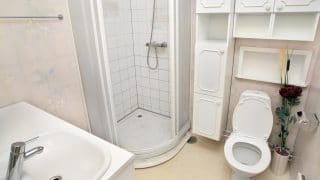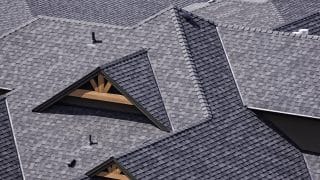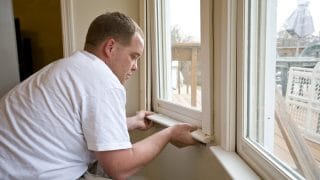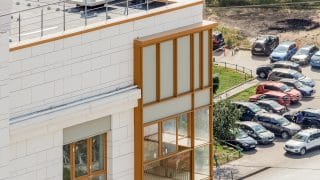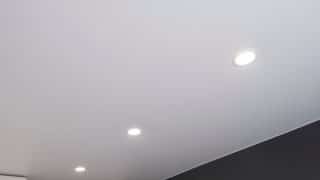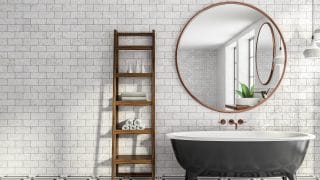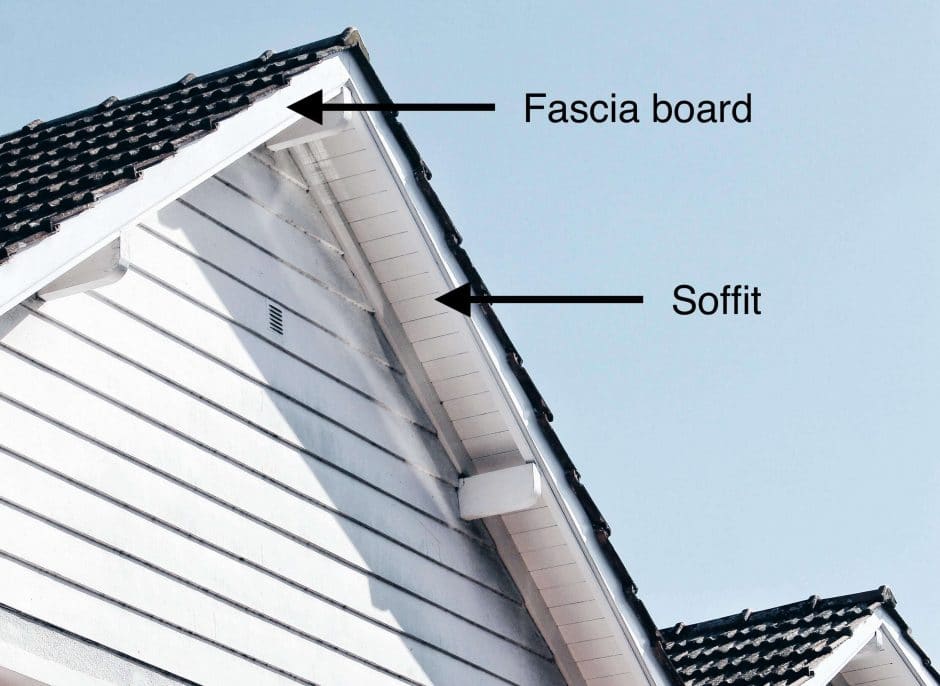
When planning a roof project, you’ll often hear soffit and fascia mentioned in the same breath. Together, this pair of roofing materials serves aesthetic and functional purposes. They cover unfinished structural parts of the roofline while protecting it from exposure to water, pests, and other potential damage.
While soffit and fascia work together, are installed near each other, and work together to serve a similar function, they are quite different. Read on to learn the differences between the two.
What is a soffit?
Picture a building with a roof that hangs over the exterior wall. This overhang is called the eave. When you look up, you might see that the area beneath the eaves is protected by soffit.
Soffit is siding or other material that runs from the edge of the exterior walls to the edge of the eave. It conceals those raw, unfinished rafter tails from view for curb appeal. On a practical level, soffit prevents moisture from getting into the roof deck to damage the home and blocks pests like insects, birds, and squirrels from the attic.
Soffit can be made of materials such as wood, vinyl, or aluminum. Some soffit panels have pre-cut holes for ventilation. Other soffit panels are solid, and require the vents to be installed to ensure airflow.
Note that not all eaves—and thus not all homes—have soffit, as some homeowners prefer the look of exposed rafters.
What is fascia?
Fascia, which is Latin for “band,” is the board that runs along the roofline where the roof and walls of the house meet, installed perpendicular to soffit. Fascia can be made of several materials: wood, vinyl, composite, plastic, and aluminum.
Like soffit, fascia board also covers up the rough look of the rafters while keeping moisture and pests out of the home. But fascia has a few other important jobs. Gutters and drain pipes are secured to the fascia as part of the system that protects the roof from weather damage. Because fascia is installed at the edge of the roof, it can support the bottom row of the roof’s tiles or slates as well.
When planning a roof project, you’ll often hear soffit and fascia mentioned in the same breath. Together, this pair of roofing materials serves aesthetic and functional purposes. They cover unfinished structural parts of the roofline while protecting it from exposure to water, pests, and other potential damage.
While soffit and fascia work together, are installed near each other, and work together to serve a similar function, they are quite different. Read on to learn the differences between the two.
What is a soffit?
Picture a building with a roof that hangs over the exterior wall. This overhang is called the eave. When you look up, you might see that the area beneath the eaves is protected by soffit.
Soffit is siding or other material that runs from the edge of the exterior walls to the edge of the eave. It conceals those raw, unfinished rafter tails from view for curb appeal. On a practical level, soffit prevents moisture from getting into the roof deck to damage the home and blocks pests like insects, birds, and squirrels from the attic.
Soffit can be made of materials such as wood, vinyl, or aluminum. Some soffit panels have pre-cut holes for ventilation. Other soffit panels are solid, and require the vents to be installed to ensure airflow.
Note that not all eaves—and thus not all homes—have soffit, as some homeowners prefer the look of exposed rafters.
What is fascia?
Fascia, which is Latin for “band,” is the board that runs along the roofline where the roof and walls of the house meet, installed perpendicular to soffit. Fascia can be made of several materials: wood, vinyl, composite, plastic, and aluminum.
Like soffit, fascia board also covers up the rough look of the rafters while keeping moisture and pests out of the home. But fascia has a few other important jobs. Gutters and drain pipes are secured to the fascia as part of the system that protects the roof from weather damage. Because fascia is installed at the edge of the roof, it can support the bottom row of the roof’s tiles or slates as well.
Another type of fascia is found in building decks. Here the board is installed along the perimeter, just below the surface line of the deck, to help cover unfinished joists and other structural support.
What are the best soffit and fascia materials?
Together, soffit and fascia protect your home from pest and water damage so durable materials are the best option if they are within your budget. Builders can choose from several materials and each have their pros and cons.
- Wood is convenient, inexpensive, and the most traditional choice. Simply use the material from the roofing deck and cut the boards to the size you need. The downside is that wood boards aren’t water resistant without special coats of paint, which require upkeep. Homeowners must check wood periodically for peeling paint, rot, mold, warping, and insects, and repair or replace as needed.
- Vinyl is an inexpensive yet durable option, and it can be installed right over wood fascia to make it longer lasting. Vinyl soffits are extremely popular because vinyl is easy to maintain and resistant to damage like water, rot, rust, and insects. But while vinyl doesn’t warp from water like wood, it can still expand and shrink due to temperature changes. And for vinyl to protect, it must stay tightly sealed.
- Aluminum can be installed alone or on top of wood. It is both durable and easy to bend to fit the shape of your roof. But it’s also more expensive and usually requires an expert to install.
- Composite is composed of recycled wood chips, sawdust, and plastic bonded with epoxy resin. It holds up well over time and maintains its color whereas materials like painted wood can fade. It even comes in finishes that mimic wood grain without the upkeep that wood requires. But those color choices may be limited compared to other options, and composite can be pricey.
MT Copeland offers video-based online classes that give you a foundation in construction fundamentals with real-world applications.
Classes include professionally produced videos taught by practicing craftspeople, and supplementary downloads like quizzes, blueprints, and other materials to help you master the skills.

